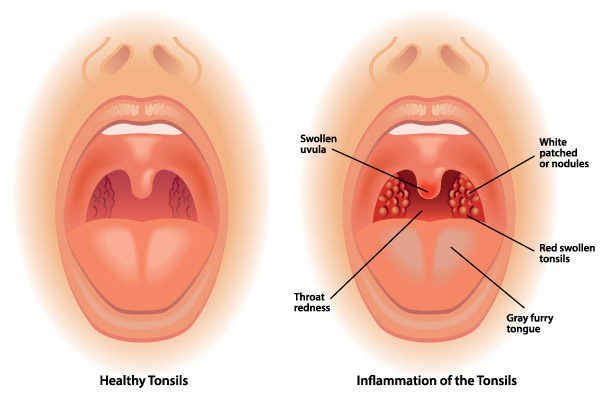Your child’s tonsils can be found at the back of his throat, where it acts as a filter that traps germs, thus preventing them from entering his body and causing an infection. However, there may be times when the tonsils are infected and become swollen and/or inflamed – this condition is known as tonsillitis.
Recognising Tonsillitis
Tonsillitis can be a common occurrence in children. When it does occur, it may happen occasionally or it might be a recurring condition. Any kind of bacteria or virus can infect the tonsils and cause tonsillitis. The main symptoms are fever and sore throat, but there are other symptoms and signs to watch for, namely:
- Redness of the tonsils
- A white or yellow coating on the tonsils
- Painful blisters or ulcers on the throat
- Hoarseness or loss of voice
- Headache
- Loss of appetite
- Ear pain
- Difficulty swallowing or breathing through the mouth
- Swollen glands in the neck or jaw area
- Fever, chills
- Bad breath
Your child may also exhibit different symptoms such as:
- Nausea
- Vomiting
- Abdominal pain
Treating Tonsillitis
If your child has tonsillitis, make sure you consult with your paediatrician for treatment. Once your child’s doctor has determined the cause, he will be able to take the appropriate steps to treat or alleviate the condition. If the tonsillitis was caused by bacteria, he may prescribe a course of antibiotics. However, if it was caused by a virus, your child’s body will have to fight off the infection on its own. Strep throat will need to be treated with antibiotics to kill the bacteria Streptococcus viridans that causes it.
What you can do
Regardless of the cause of your child’s tonsillitis, there are several things you can do to ensure that he is more comfortable, which includes:
- Ensuring that he gets enough rest
- Drink either warm or very cold fluids to help alleviate any throat pain
- Ensure that the humidity in your room is maintained (use a cool-mist vaporizer or humidifier for this)
- Let him gargle with a warm solution of salt and water
- Give appropriate fever medicine to relieve the pain.

Tonsil removal – not always necessary
Your child’s tonsils have an important role to play in his immune system throughout his life, so it would be best not to remove them. Often, a ‘wait-and-see’ approach is best as the so-called benefits of tonsillectomy (surgery to remove the tonsils) may not actually be the right answer.
While tonsillectomy can reduce the frequency of your child’s throat infections, his bouts of tonsillitis will probably occur less often as he grows older. The biggest drawback to tonsillectomy is that just like any surgical procedure, the operation itself is painful and its benefits are sometimes marginal at best.
So don’t rush into having your child’s tonsils removed just because he has frequent mild throat infections. In general, tonsillectomy should only be considered if your child’s tonsils become swollen to the point of obstructing his upper airway and/or causes difficulty eating/swallowing. A definite indication for adenotonsillectomy is obstructive sleep apnoea caused by enlarged tonsils and adenoids obstructing the upper airways. This causes the child to snore badly and also momentarily stop breathing, leading to coughing and spluttering after.
As long as his tonsillitis does not cause him undue distress (e.g. he is not sick, is able to breathe easily at night, and is able to sleep well) there is little reason to have them removed.
An educational contribution by Malaysian Paediatric Association.






Comments